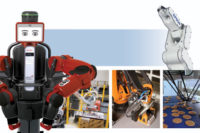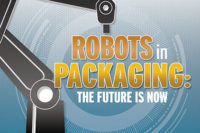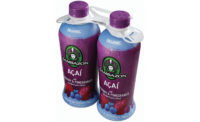Cover Story: Robotics
Generation 'R': The latest on robots in packaging
A new wave of robots has arrived, addressing packagers’ concerns for speed, space savings and easy integration.








Robots are increasing in popularity for use in packaging both here in the U.S. and across the pond. Market Analyst IMS Research (www.imsresearch.com) issued a study reporting that the UK market for robots will grow by 3.4% from 2011 to 2016 as a result of increased investment in automation by food and drink manufacturers.
The popularity of robots in packaging is becoming more and more evident as manufacturers choose to automate their packaging processes. Today’s generation of packaging robots is progressing, becoming smarter, faster and more compact.
Small and fast
In order to address the growing need for speed amongst packagers, FANUC Robotics designed its new M-710iC/50H robot for high-speed transferring and packing.
“Our customers require higher speeds and accuracy to meet their production goals,” says Philip Zanotti, product manager, FANUC Robotics America.
The five-axis robot is equipped with the iRVision® line tracking and offers a compact size, which allows it to work in small spaces without sacrificing speed. Its lightweight and compact size also addresses a growing concern over facility space, checking both speed and small size off its checklist.
Various robot companies are also marrying speed and small size for the ultimate efficient robot. Designed specifically for high-speed picking, packing, cartoning and kitting applications, the delta-style Motoman MPP3 robot from Yaskawa Motoman is capable of 150 cycles per minute. The MPP3 robot features a three-arm configuration with a direct-driven rotary axis to increase reliability at high speeds. Its long arms with shorter-arm radii provide a compact footprint and a deeper reach, while providing a large working envelope. The MPP3 is powered by the FS100 controller featuring a compact footprint and open software architecture for applicability in a wide variety of applications.
The Schneider Robotic Vertical Carton/Case Loader, (RVCL) is intended for precise, high speed product handling. Its vision guided, four-axis M3 robotic arms (for bigger payloads) locate, inspect and orient the product for high speed nesting and placing. The robot can handle complex shapes, packing them tightly for maximum sustainability. Its modular design increases throughput and can be configured to top load cartons, cases or trays, and easily accommodates additional modules/robots for increased production. The system is built for very high efficiency, rapid changeovers and simple maintenance.
Robots with a lighter weight and smaller footprint save plant floor space without sacrificing the high speeds customers demand. Compact size doesn’t mean compact results for Mitsubishi Electric Automation’s new RH-3SxHR robot.
The RH-3SxHR is a ceiling-mounted SCARA robot designed to maximize speed for picking and handling light-weight parts. Its compact design and overhead installation requires a smaller, less-expensive mounting structure, while its rigid construction provides improved strength and precision. Its light weight ensures easier installation and the reduced overall machine footprint saves space but does not sacrifice work envelope. The robots are available in a wash proof version for food applications.
ABB Robotics also unveiled a smaller and faster robot that can be mounted overhead to save on facility space. The new IRB 120T, weighing only 55 pounds, is a faster version of ABB’s compact, flexible, multipurpose 6-axis robot.
Trending Now: What to watch for as robotics change today for tomorrowAccording to Dick Motley, Sr. account manager, national distribution sales, FANUC Robotics, there are distinguishable trends emerging in robotics for the food and beverage packaging industry.
|
The IRB 120T is ideal for assembly and pick and place applications requiring extensive reorientation of the product, commonly found in the food and beverage and consumer packaging industries. The IRB 120T provides significant increases in the maximum speeds of axes 4, 5 and 6, delivering increased cycle speeds from the standard IRB 120 model.
“As the installed base of the IRB 120 spread into numerous industries over the last two years we found there was a need for a faster version for many assembly and pick and place applications,” says John Bubnikovich, executive director, marketing and business development, ABB Robotics. “The increasing demand for higher outputs in consumer goods industries requires the most efficient and cost effective equipment. We are pleased to support this need with the new IRB 120T.”
Not only is the robot smaller and faster, but it is easy to integrate into new and existing lines. It can be mounted at any angle, either in a cell, on top of a machine or in close proximity to other robots on the line. All IRB 120 models are available with the compact version of the industry-leading IRC5 controller, making it easy to program and control for a variety of tasks.
Smarter machines
Packagers want speed and accuracy, flexibility and easy installation. Packagers also want robots that can promptly integrate into production lines, learn the cycle quickly, lessening downtime and increasing output.
Combining speed, flexibility and ease of use, the new FlexiBowl from Adept Technology, Inc. is a vision-based robotic parts feeding solution available as an option on all Adept robot systems. The Adept FlexiBowl utilizes circular band tracking to simplify and speed the robotic acquisition of component pieces used in material handling and kitting applications. Adept FlexiBowl is capable of quickly separating and orienting a wide variety of pieces, including food items.
“Unlike traditional vibratory bowl feeders, which have limited flexibility due to their high level of customization, the Adept Flexibowl utilizes Adept vision technology to create a truly flexible standard parts feeding solution that can be deployed and redeployed quickly eliminating the time, cost and complexity associated with traditional parts feeding,” says John Dulchinos, president and chief executive officer of Adept Technology. “The Adept FlexiBowl dramatically increases the flexibility of a robotic system opening up new applications to automation.”
In addition to handling a wide array of pieces, the Adept FlexiBowl operates reliably and quietly and is extremely easy to operate. The feeder features serial interface connections, encoder latching and a small footprint. Benefits include quick and easy installation, throughput between 30 to 60 parts per minute and easy maintenance and cleaning.
New technology is here to help packagers integrate robots into their exiting lines and its making it easier than ever. Yaskawa Motoman announces new LabVIEW and ROS-Industrial support for the FS100 and DX100 controllers. LabVIEW users can now readily integrate Motoman robots into their production or quality control applications. A new Yaskawa Motoman Robotics Library (YMRL) for LabVIEW 2012 facilitates the programming of Motoman robots into applications using the LabVIEW graphical interface. Researchers developing new robotics algorithms or applications can now adopt any Motoman robot into their work.
“Yaskawa Motoman is working to democratize robotics. Historically, the industry approach has been based on proprietary languages. The users were expected to know the robot OEM’s language or learn it,” says Erik Nieves, technology director. “We believe this has stunted the adoption of robotics into new markets. Instead, we continue to introduce new means to program our robots including RSLogix, LabVIEW and ROS. These well-established programming frameworks are familiar to users in various markets and will accelerate the growth of robotics into new areas.”
Facing demands for flexibility, efficiency and ease of use, packagers are more and more turning to robotics for their packaging needs. Today’s new generation of robots hit the mark for speed, small size and smarter operation, and sometimes incorporate all three.
Looking for a reprint of this article?
From high-res PDFs to custom plaques, order your copy today!












